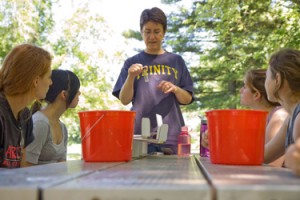
Alison J. Draper (center), director of the Trinity Science Center and lecturer in interdisciplinary science, conducts a field research training session last summer with (l-r) Jessica Voight ’17, Connie Ky ’17, Catherine Poirier ’17, and Cassandra Cronin ’17.
Twelve undergraduate students from around the country will come to Trinity College this summer to participate in a new Summer STEM Teaching Experiences for Undergraduates from Liberal Arts Institutions (TEU) program, thanks to a grant from the National Science Foundation (NSF).
“The goal of the NSF grant is to increase the number of students from liberal arts institutions who are preparing to teach math and science,” said Trinity Science Center Director Alison J. Draper, who is also a lecturer in interdisciplinary science.
Draper is a principal investigator on the grant, along with two mathematicians from Vassar College and Bryn Mawr College. The grant of $2,137,727 is being awarded to Vassar, with $685,445 of that going to Trinity. Brown University, Bryn Mawr, and Barnard College are also partners on the grant, which will fund the TEU program for five years.
Undergraduate students from a network of about 60 liberal arts colleges and universities, Trinity students included, are eligible to apply for the program. Twelve students will participate in a mathematics TEU program at Brown, and 12 will participate in a science TEU program at Trinity, teaching science workshops to 10th-grade students from Hartford Magnet Trinity College Academy. The grant also will pay for instructors who will train the undergraduates to teach high school students and will supervise them in the classroom and in the field.
As part of Trinity and HMTCA’s ongoing education partnership, students must take a writing workshop before 9th grade and a science workshop before 10th grade to maintain a spot in the award-winning magnet school. The summer science workshop has been held at Trinity for the past four years. “Our goal for the science workshop was to model how science was done in the real world,” Draper said. With a Connecticut Health and Educational Facilities Authority grant last summer, Draper trained eight Trinity students to teach the HMTCA workshops. “What will be different under NSF is that the undergrads won’t be necessarily from Trinity,” Draper said.
Robert Cotto, Jr.obert Cotto, Jr., director of urban educational initiatives and lecturer in educational studies at Trinity, said that one of the motivations for the HMTCA partnership is to allow high school students to have a positive, early experience on a college campus. The new TEU program will help to build that relationship and to expand its benefits to undergraduates from many other colleges. “This is a perfect example of how we’re able to be a liberal arts college and leverage our position as being in a city and having different partnerships already on the ground that not only Trinity students can take advantage of but now even a national group of students can participate in,” Cotto said.
The program also will serve as a way to develop and to test a model that can be shared and duplicated. Draper said, “We would really like other institutions in other parts of the country to be able to pick up this model and mount their own program. We think it’s a good idea, and it serves a whole bunch of purposes all at once. We’re serving the purposes of HMTCA, but we’re also serving our own students and students at partner institutions, so it’s a win-win-win.”
Written by Andrew J. Concatelli





Leave a Reply